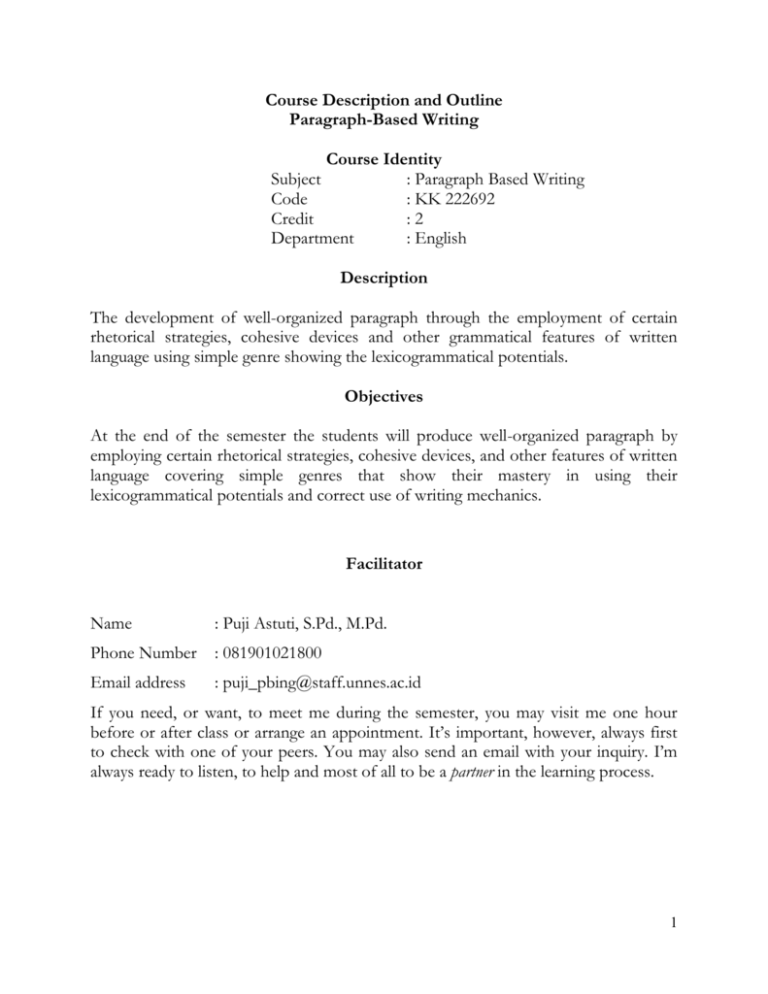
Course Description and Outline
Paragraph-Based Writing
Course Identity
Subject
: Paragraph Based Writing
Code
: KK 222692
Credit
:2
Department
: English
Description
The development of well-organized paragraph through the employment of certain
rhetorical strategies, cohesive devices and other grammatical features of written
language using simple genre showing the lexicogrammatical potentials.
Objectives
At the end of the semester the students will produce well-organized paragraph by
employing certain rhetorical strategies, cohesive devices, and other features of written
language covering simple genres that show their mastery in using their
lexicogrammatical potentials and correct use of writing mechanics.
Facilitator
Name
: Puji Astuti, S.Pd., M.Pd.
Phone Number
: 081901021800
Email address
: puji_pbing@staff.unnes.ac.id
If you need, or want, to meet me during the semester, you may visit me one hour
before or after class or arrange an appointment. It’s important, however, always first
to check with one of your peers. You may also send an email with your inquiry. I’m
always ready to listen, to help and most of all to be a partner in the learning process.
1
Strategies
The lecture is conducted by:
- lecturing
- discussing
- cooperative learning
- guiding writing both individually and in groups
- encouraging students to obtain materials to write via many ways, such as, doing
observation, reading, interviewing, etc.
- editing writing
- giving tasks, homework, etc.
Pre-Requisite
Students should complete ‘Sentence-Based Writing’
References
Required Book
Cynthia A. Boardman & Jia Frydenberg. 2002. Writing to Communicate: Paragraphs and
Essays. New York: Pearson Longman
Relevant Books:
Gerot, L. & P. Wignell. 1995. Making Sense of Functional Grammar. NSW: Antipodean
Educational Enterprises.
Halliday, M.A.K. 1985. Spoken and Written Language. Victoria: Deakin University Press.
Hamp, Liz., Lyons Ben Heasly. 1987. Study Writing. Cambridge: Cambridge University
Press.
Harmer, Jeremy. 2004. How to Teach Writing. England: Longman.
Pavlik, Cheryl., Margaret Keenan Segal. 2003. Interactions 2 Writing. Boston: Mc
Graw Hill Contemporary.
Wishom, G. & J.M. Burks. 1980. Let’s Write English. New York: Litton Educational
Publishing International.
Materials
1 Introduction to academic writing
2 What a paragraph is and the format
3 Types of paragraph: the narrative, descriptive and expository
2
4
5
6
Steps of writing a narrative paragraph
Development of basic organization into narrative paragraph
Steps of writing a descriptive paragraph
Development of basic organization into descriptive paragraph
Steps of writing an expository paragraph
Development of basic organization into expository paragraph
7
8
9
10 Using clues to write a paragraph
11 Finding coherence in sample texts
12 Recognizing cohesive devices in sample text (linking words, personal pronouns, definite article,
demonstrative pronouns and synonyms)
13 Recognizing mechanics in sample text (punctuation mark, using commas for transitions and
adverbial clauses, fragments).
14 Unity and completeness
Assignments
1. Creating a paragraph of which the topic sentence is given.
2. Creating a paragraph as to give response to a provided reading; such as article
of a newspaper, and advertisement, an announcement, etc.
3. Creating a paragraph as to continue a given information.
Assessment
1
2
3
4
Attendance
Class participation
Mid portfolio check
Final portfolio check
: 10%
: 20%
: 30%
: 40%
Sessions
Session One:
Welcoming Remarks, Classroom Management, Discussion on the Syllabus of the
Course
Session Two:
Introduction to academic writing
Session Three:
What a paragraph is and the format
Session Four:
Types of paragraph: the narrative, descriptive and expository
Session Five:
Steps of writing a narrative paragraph
3
Session Six:
Development of basic organization into narrative paragraph
Session Seven:
Steps of writing a descriptive paragraph
Session Eight:
Development of basic organization into descriptive paragraph
Session Nine:
Steps of writing an expository paragraph
Session Ten:
Development of basic organization into expository paragraph
Session Eleven:
Using clues to write a paragraph
Session Twelve:
Finding coherence in sample texts
Session Thirteen:
Recognizing cohesive devices in sample text (linking words, personal pronouns,
definite article, demonstrative pronouns and synonyms).
Session Fourteen:
Recognizing mechanics in sample text (punctuation mark, using commas for
transitions and adverbial clauses, fragments).
Session Fifteen:
Building unity and completeness.
Session Sixteen:
Closing remarks, review, and technicalities of portfolio submission
OUTLINE
No.
Topic
1. Welcoming Remarks, Classroom
Management, Discussion on the
Syllabus of the Course
Theory Practice Meeting
X
1
2.
Introduction to academic writing
X
X
2
3.
What a paragraph is and the
format
X
X
3
4.
Types of paragraph: the narrative,
descriptive and expository
X
X
4
4
5.
Steps of writing a narrative
paragraph
X
X
5
6.
Development
organization
paragraph
basic
narrative
X
X
6
7.
Steps of writing a descriptive
paragraph
X
X
7
8.
Development
organization
paragraph
basic
narrative
X
X
8
9.
Steps of writing an expository
paragraph
X
X
9
10. Development
of
basic
organization into expository
paragraph
X
X
10
11. Using clues to write a paragraph
X
X
11
12. Finding coherence in sample
texts
X
X
12
13. Recognizing cohesive devices in
sample text (linking words,
personal pronouns, definite
article, demonstrative pronouns
and synonyms).
14. Recognizing mechanics in sample
text (punctuation mark, using
commas for transitions and
adverbial clauses, fragments).
15. Building unity and completeness.
X
X
13
X
X
14
X
X
15
16. Closing remarks, review, and
technicalities of portfolio
X
X
16
of
into
of
into
5
submission
6







